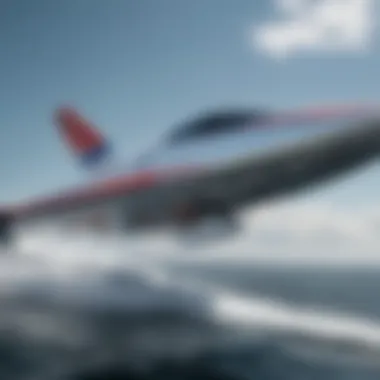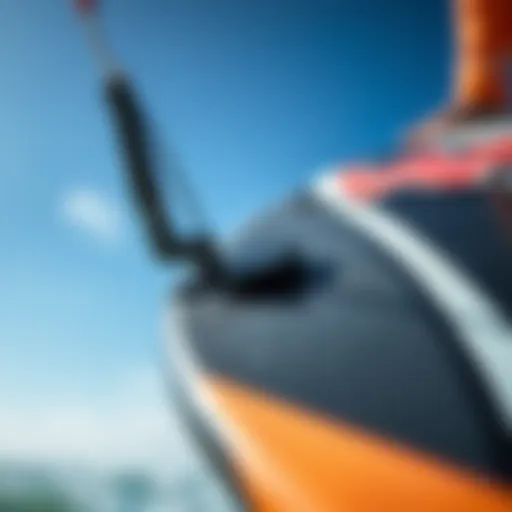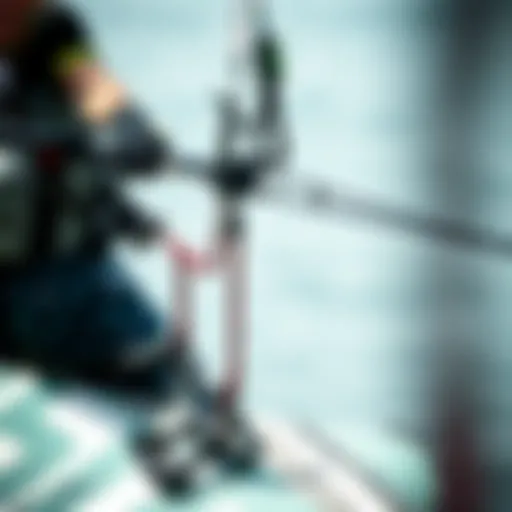Understanding the Cost Factors of Hydrofoils


Intro
Hydrofoils have taken the world of kiteboarding by storm, becoming a game changer for enthusiasts of all skill levels. They offer a unique sensation, gliding above the water with minimal drag, enabling riders to experience speed and maneuverability like never before. However, with this excitement comes a complex pricing structure that can boggle the mind. What exactly goes into the cost of these innovative watercraft?
In this exploration, we will embark on a journey through the various components that shape the price of hydrofoils. From cutting-edge technology to the quality of materials used, the factors influencing costs are as diverse as the riders themselves. Moreover, we’ll shed light on the differences between budget models and top-tier options, ensuring that every kiteboarder, instructor, marketer, or travel agent among you is well-equipped with knowledge to make informed decisions.
By the time you reach the end of this article, you will have a solid understanding of not just how much you might spend on a hydrofoil, but also why those prices can differ significantly. Ready to dive in? Let’s get started on understanding the intricate world of hydrofoil economics!
Prelude to Hydrofoils and Their Pricing
Understanding the cost component of hydrofoils is paramount for anyone dabbling in this exhilarating water sport. Hydrofoils are more than just a trendy addition; they represent a significant investment that can enhance the kiteboarding experience. This section lays the groundwork for comprehending the various factors involved in the pricing of hydrofoils, ensuring that buyers and enthusiasts alike grasp what they are getting into.
Understanding Hydrofoils
To appreciate why hydrofoils can be a bit pricey, it helps to know what they actually are. At their core, hydrofoils are devices that lift the board out of the water, reducing drag and allowing for smoother rides at high speeds. Think of them like the wings of an airplane—designed to provide lift and enhance performance. The construction and functionality of hydrofoils look pretty simple on the surface but are backed by impressive engineering principles that require expert craftsmanship.
- Basic Functionality: Hydrofoils work through hydrodynamic lift. As the board moves through the water, the foils generate upward force, keeping the board elevated. This minimizes water resistance, and in turn, maximizes efficiency.
- Types of Hydrofoils: They vary in shape and size, from beginner-friendly models to advanced ones that cater to seasoned pros. Each type influences its price point due to the complexities involved in their design.
- Market Adaptation: The evolution of hydrofoils has made them more accessible, yet prices can still swing high for specialized designs. Understanding these variances helps in making informed purchases.
What Influences the Cost of Hydrofoils?
Several variables play a role in determining how much a hydrofoil is going to set you back:
- Materials Used: High-quality materials such as carbon fiber or aluminum can drastically increase the price. Lighter and stronger materials not only aid performance but contribute to durability as well.
- Manufacturing Technology: Techniques like precision molding or CNC machining enhance the quality and performance of hydrofoils. The technology investment involved reflects on the final cost.
- Brand Reputation: Established brands often command higher prices due to a history of producing reliable, high-quality products. Popular names in the industry come with their price tags!
- Customization: Some manufacturers allow for tailor-made options which can inflate costs. Personalizing your hydrofoil could be tempting, though it may cost you.
- Market Demand: Much like any other consumer goods, demand can drive prices up, especially during peak seasons or after a sporting event that puts hydrofoiling in the limelight.
"The price of a hydrofoil isn't just about the sticker shock; it's about understanding the engineering and materials that make it a game changer on the water."
In summary, hydrofoils are marvels of modern engineering and come with intricacies that reflect in their pricing. Knowing these elements can lead to better purchasing decisions, whether you are a newcomer or a seasoned kiteboarding aficionado.
The Technology Behind Hydrofoils
The realm of hydrofoils represents a fascinating intersection of engineering and aquatic sports. Understanding the technology behind hydrofoils is crucial for anyone invested in this field, whether you’re a kiteboarding enthusiast, an instructor, or a marketer in the watersport industry. The advanced engineering principles that define hydrofoils not only enhance performance but also influence cost structures in a significant way.
When we look at hydrofoils, we see a design that allows for efficient lift and reduced drag when in motion. This technology enables riders to glide smoothly above the surface of the water. The importance of these elements cannot be overstated: they serve to optimize speed, control, and overall performance.
Design and Engineering Considerations
The design of a hydrofoil is a complex process. Engineers often start with the hydrofoil's shape, which can vary widely depending on intended use. A common consideration here is the aspect ratio—the relationship between the length and height of the foil. Higher aspect ratios typically mean greater efficiency at high speeds, but may compromise stability.
Several aspects factor into engineering decisions:
- Aerodynamic Shape: A well-designed foil has a shape that minimizes water resistance, allowing it to slice through the surface cleanly.
- Stability Features: Riders need stability, especially in turbulent waters. Many hydrofoils incorporate stability fins or various contours to assist in this regard.
- Weight Distribution: The placement of the hydrofoil on the board affects its performance. A lower position can provide enhanced lift, while a higher placement may help with maneuverability.
Making these design choices requires a blend of scientific knowledge and creative thinking. The engineering behind these aspects not only influences the hydrofoil's performance but also its durability and ultimately, its cost.


Materials Used in Hydrofoil Construction
The choice of materials for hydrofoil construction plays an essential role in determining both performance and cost. Typically, hydrofoils are made from a few key materials, each offering unique benefits:
- Aluminum: This is a common choice for budget-friendly options. Aluminum hydrofoils are relatively lightweight and do not break the bank. However, they can be susceptible to corrosion if not properly maintained.
- Carbon Fiber: For mid-range to high-end models, carbon fiber is often favored. It offers a great strength-to-weight ratio, which means a faster, more responsive ride. However, this type of material can drive up costs significantly.
- Foam Core Composites: Some advanced hydrofoils utilize foamed interiors. This cuts down on weight while maintaining strength, often seen in premium products.
The choice of materials does not merely affect initial costs; it impacts long-term usability and resale value as well. For instance, while carbon fiber models demand a higher price upfront, they tend to last longer, keeping their performance levels intact over time.
"A hydrofoil that’s built with quality materials may cost more, but the investment pays off in performance and longevity."
Market Segmentation and Product Range
Understanding the diverse landscape of hydrofoils is vital for anyone looking into this exciting niche of water sports. By segmenting the market, we can better appreciate the various product ranges available, tailored to meet different preferences and needs. Each segment offers distinct characteristics, target audiences, and pricing tiers, allowing users—from seasoned kiteboarders to newcomers—to make informed decisions.
Budget Hydrofoil Options
For those just stepping foot into the world of hydrofoils, budget options provide an accessible entry point. These models are designed with affordability in mind, without sacrificing the essential features necessary for a satisfying ride. Generally, these hydrofoils are made with more basic materials which may lack the advanced technology found in pricier models. However, they provide a solid foundation for learning and experimentation.
- Key Features:
- Simpler designs that are easier to handle
- Suitable for beginners or those who paddle occasionally
- Basic materials, often aluminum or basic composites
Budget hydrofoils also have the advantage of less anxiety about damaging an expensive piece of gear, allowing newer riders to practice freely. As the saying goes, “You’ve gotta start somewhere!”
Mid-range Hydrofoil Models
Once you've got your sea legs, mid-range hydrofoils begin to shine, offering a balance between quality and price. These models often incorporate improved materials and technology, enhancing overall performance. Riders might expect features such as better stabilization, increased speed, and more responsive control.
- Notable Aspects:
- Typically constructed with high-grade composites or advanced aluminum
- Improved design for smoother rides
- Suitable for advancing kiteboarders who want more out of their experience
If you're riding more frequently and investing time into the sport, mid-range options can provide the investment that pays off with enhanced performance.
High-End Hydrofoil Brands
For enthusiasts who are serious about kiteboarding, high-end hydrofoils represent the pinnacle of performance and quality. These systems are finely crafted with cutting-edge technology, ensuring optimal performance for high-speed maneuvers and when tackling rough waters. The price tag matches the quality, but for many riders, it is well worth the investment.
- Defining Characteristics:
- Premium materials like carbon fiber, ensuring lightweight strength
- Innovative designs that offer customizability
- Tailored for professionals or those seeking competitive advantages
Investing in a high-end hydrofoil often means unlocking exceptional features such as superior hydrodynamics and unique aesthetics. These models can turn your average day on the water into an exhilarating experience, elevating your skills with advanced technology.
"Investing in quality gear can be the difference between just going for a ride or truly enjoying the freedom that hydrofoils offer."


In summary, the market segmentation of hydrofoils illustrates the diverse range of products available, catering to various skill levels and budgets. Understanding these nuances helps aspiring kiteboarders choose what fits their needs, ensuring they enjoy every moment on the water.
Comparative Analysis of Hydrofoil Costs
When it comes to understanding hydrofoil pricing, a comparative analysis of costs is pivotal. Kiteboarding enthusiasts, whether novices or seasoned riders, often face a challenging decision-making process. They must evaluate multiple factors, including performance, materials, brand reputation, and their own budgets. This section aims to break down these costs into digestible parts, thus empowering readers to make informed choices that align with their needs.
Price Comparison Across Popular Brands
The landscape of hydrofoil brands is quite vast and varied. Each company brings something unique to the table, and prices can fluctuate based on several parameters.
For instance, brands like Naish, known for their top-notch materials and innovative designs, tend to set a higher price point. On the other hand, you may find budget-friendly options from brands such as Aquaglide or Liquid Force. Below is a basic price comparison:
- Naish hydrofoils: $1,500 - $3,000, usually emphasizing performance and durability.
- Slingshot: $1,200 - $2,500, often regarded for their robust build and versatility.
- Cabrinha: $1,300 - $2,800, appealing for their advanced technology and sleek designs.
- Liquid Force: $800 - $1,800, positioned as an excellent entry-level option.
This range suggests that buyers need to assess what they’re getting for their investment. It's not just about the tag price, but more about the value each hydrofoil brings, tailored to one’s personal taste and riding style.
Performance vs. Cost: A Critical View
Cost and performance are to hydrofoiling what yin and yang are to balance. While higher-cost hydrofoils often come with advanced technology—such as carbon fiber construction or elevated lift capabilities—they still may not align with every rider's expectations.
- Performance-oriented foils: These tend to be pricier, catering to high-performance riders who seek speed and agility. But, they can be overkill for those just starting or riding in lighter winds.
- Budget options: They might not have all the bells and whistles, but many provide a reasonable riding experience for amateurs. Just because they are affordable doesn’t mean they are incompetent; some are surprisingly effective for casual use.
What’s essential here is to recognize that performance is subjective. A foil that works wonders for an expert kiteboarder may be a hurdle for someone still getting the hang of things. It's important to balance what you need with what you can afford. In practice, this might look like opting for a middle-ground model, which offers decent performance without breaking the bank.
"Understanding the relationship between cost and performance is key to making an informed purchase that meets your personal riding goals."
In summary, taking a close look at how different brands position their products in terms of cost versus performance can yield crucial insights. It can save kiteboarders from overspending on features they might never use while ensuring they don't miss out on quality products that suit their style.
Economic Implications for Kiteboarding Enthusiasts
When discussing the world of hydrofoils, it’s not just about the fun that comes with kiteboarding. The economic implications hold a significant place, especially for enthusiasts who are serious about the sport. Understanding the balance between cost and value can offer kiteboarders, instructors, and even marketers deeper insights into their investments. For many, it’s about making informed choices that bring joy without breaking the bank.
Cost vs. Value: Making Informed Choices
Diving into the waters of hydrofoil pricing can feel like a leap of faith for many kiteboarding enthusiasts. Price tags can range from a few hundred to several thousand dollars. So how do you navigate this financial maze?
- Assess your needs. The first step is to take a good look at what kind of riding you plan to do. Are you a weekend warrior aiming for leisurely sessions? Or perhaps, you're aspiring to compete at a higher level? Identifying your aspirations can help clarify what features matter most in a hydrofoil.
- Evaluate performance. The performance of hydrofoils often correlates directly with their prices. Higher-end models might come equipped with advanced technology and construction materials that improve lift and stability, which is great for more ambitious riders. This could lead to spending more, but the value you gain in performance might justify the cost.
- Consider long-term benefits. Spending a bit more upfront on quality hydrofoils can mean durability and fewer replacements down the line. If you save a few bucks on a budget model, you might end up paying twice for something that does not last.
It’s useful to remember that in the world of kiteboarding, price doesn’t always equal quality. Knowledge is power, and staying informed can help avoid buyer's remorse.
Buying Used Hydrofoils: Considerations and Risks
The prospect of purchasing a used hydrofoil can be tempting. After all, who wouldn’t want to snag a good deal? But before diving headfirst into that used marketplace, consider a handful of critical factors:


- Inspect carefully. Used gear can often be a mixed bag. It’s crucial to scrutinize any signs of damage or wear, particularly in critical areas like the wings or mast. A quick visual check may save you the headaches later.
- Ask questions. Don’t shy away from reaching out to the seller. Learning about the hydrofoil's history can provide insights into its performance and overall lifespan. Key questions include how often the seller used it and if it was involved in any accidents.
- Understand warranty limitations. Often, warranties do not transfer with the sale when buying used. If something goes wrong, you might be on the hook for repairs without the safety net of a guarantee.
- Test before buying. If you can, take the hydrofoil for a spin. The feel on the water can make all the difference, and this first-hand experience is invaluable.
It’s all about weighing the possible risks against the benefits. Purchasing used equipment can stretch your budget further but requires a discerning eye.
"Invest wisely today, and your future kiteboarding adventures will thank you."
Future Trends in Hydrofoil Pricing
Understanding the landscape of future trends in hydrofoil pricing is pivotal for various stakeholders in the kiteboarding community. As the industry evolves, shifting consumer preferences and technological innovations will likely reshape how prices are set and perceived. It’s essential to recognize the underlying factors that can drive costs up or down, which could ultimately affect purchasing decisions for enthusiasts and professionals alike.
As consumers become savvier and more demanding about performance and quality, companies must adapt to these expectations. This section aims to unveil key emerging trends that will play significant roles in determining the pricing of hydrofoils in the coming years.
Technological Advancements and Their Impact
In recent years, innovations in materials science and engineering have significantly improved hydrofoil performance. These advancements not only enhance the riding experience but also come with implications for pricing.
- Material Innovation: New composite materials, such as carbon fiber and advanced plastics, contribute to lighter, stronger, and more durable hydrofoils. While these materials can drive up initial costs, they provide longevity and better performance that many kiteboarders now consider essential.
- Manufacturing Techniques: 3D printing and automated processes have begun to carve a niche in hydrofoil production, resulting in more precise designs and potentially lower manufacturing costs. However, the transition to these new methods might come with a price tag as suppliers adapt their systems.
- Smart Technology Integration: The incorporation of smart technologies, like sensors monitoring performance metrics, is gaining traction. Such features can offer valuable data to users, thereby justifying higher prices. Yet, the challenge lies in balancing sophisticated tech integration with consumer willingness to pay.
The impact of these advancements suggests a dual narrative: on one hand, as technology improves, production efficiencies could support lower prices; on the other hand, enhanced features might lead to premium pricing for the most cutting-edge designs. Hence, consumers must carefully weigh the benefits against potential price hikes.
Market Dynamics and Consumer Behavior
Market dynamics significantly influence how hydrofoils are priced. As the landscape shifts, a few trends are noteworthy in shaping consumer behavior and their buying power.
- Growing Eco-Consciousness: With greater awareness of environmental impacts, many consumers are leaning toward brands that prioritize sustainable practices. Eco-friendly materials or manufacturing processes may incur higher costs but can attract a dedicated market willing to invest in sustainability.
- Changing Purchasing Patterns: More kiteboarders are exploring online marketplaces and forums like Reddit or specialized Facebook groups to gather insights, opinions, and reviews before making a purchase. This communal approach can lead to price competition and better deals for consumers as sellers aim to meet heightened expectations for transparency and value.
- Economic Factors: Macroeconomic factors like inflation and currency fluctuations also play critical roles in pricing strategies. Changes in material costs, tariffs, and international trade agreements can ripple through the market, affecting how much individuals need to budget for hydrofoil purchases.
In summary, to navigate future pricing trends, kiteboarding enthusiasts must stay informed and adaptable. Whether you are a buyer or a seller, understanding the interplay between technology and market forces can equip you with the insights needed to make well-informed decisions.
"The relationship between technology and consumer expectations is creating a new normal in the pricing landscape for hydrofoils."
Epilogue: Navigating Hydrofoil Choices
Understanding the various cost components associated with hydrofoils is crucial for anyone involved in kiteboarding—whether you are a seasoned rider, an instructor, or even a marketer in the watersport industry. The decision-making process regarding which hydrofoil to invest in often hinges not only on price but also on materials, technology, and intended performance.
Different hydrofoil categories, ranging from budget to high-end models, emphasize that price isn’t the sole indicator of quality. For instance, budget models might serve well for beginners but can lack efficiency and durability when compared to mid-range counterparts. Conversely, high-end hydrofoils, although steep in price, bring forth cutting-edge technology and superior performance which can enhance the riding experience substantially.
The relevance of navigating these choices involves understanding both your personal priorities and how these hydrofoils align with your goals in the sport. With advancements constantly occurring in this area, keeping a finger on the pulse of trends can arm you with the knowledge to make informed decisions. For aspiring riders, this conclusion serves as the launchpad into making the right investment according to their skill level and aspirations.
Summarizing Key Insights
- Hydrofoil pricing varies significantly based on several influencing factors, such as materials used and engineering design.
- The market is segmented into budget, mid-range, and high-end options, each catering to different needs and performance results.
- Investing in hydrofoils is not merely about finding the best price; it’s about determining the balance between cost and overall value.
In sum, these insights paint a clearer picture of how intricate the world of hydrofoils can be, and with the right information, prospective buyers can confidently embark on their hydrofoil journey.
Final Thoughts for Aspiring Hydrofoil Users
For those diving into the dynamic world of hydrofoiling, it is essential to approach your options with both caution and excitement. Start by assessing your skill level and the specific kind of riding you wish to pursue.
Take the time to research brands like Slingshot, Naish, or Cabrinha, and seek out community feedback on platforms like Reddit in order to gain valuable advice and insights. Also, don't shy away from trying out used models if you are just starting; they can provide a great opportunity to test the waters without a hefty upfront investment.
Remember, a well-informed choice can turn your hydrofoil experience from a mere activity into a thrilling passion. Riding a perfectly suited hydrofoil will not only enhance your performance but also your enjoyment out on the water.







